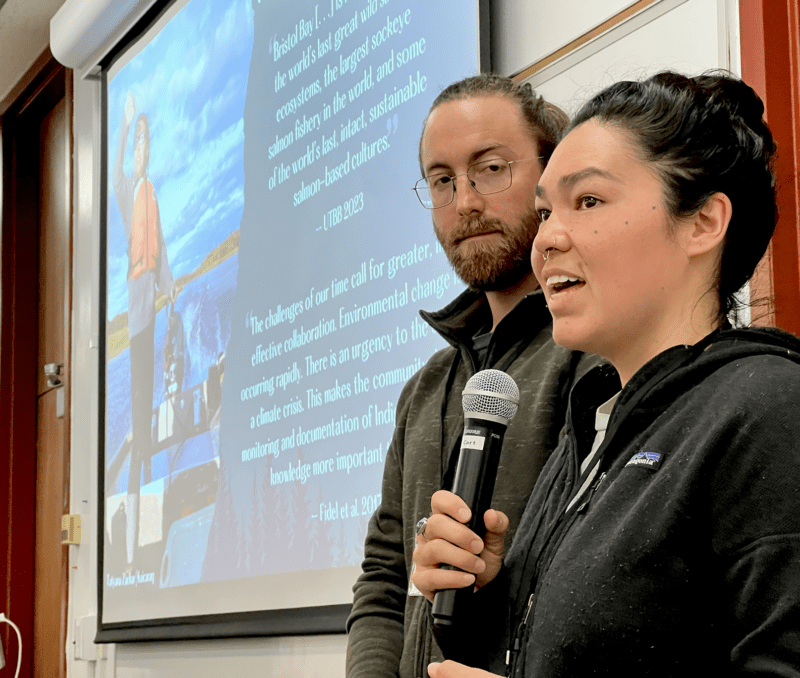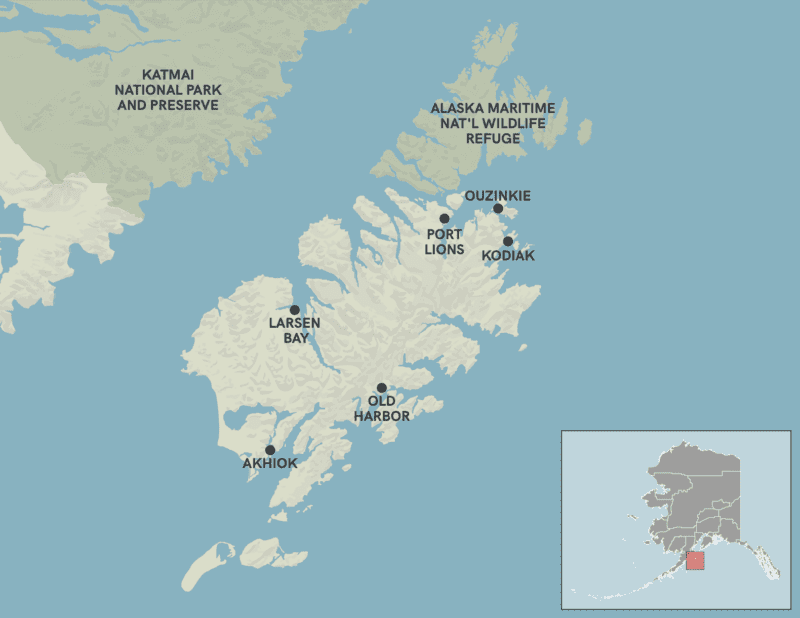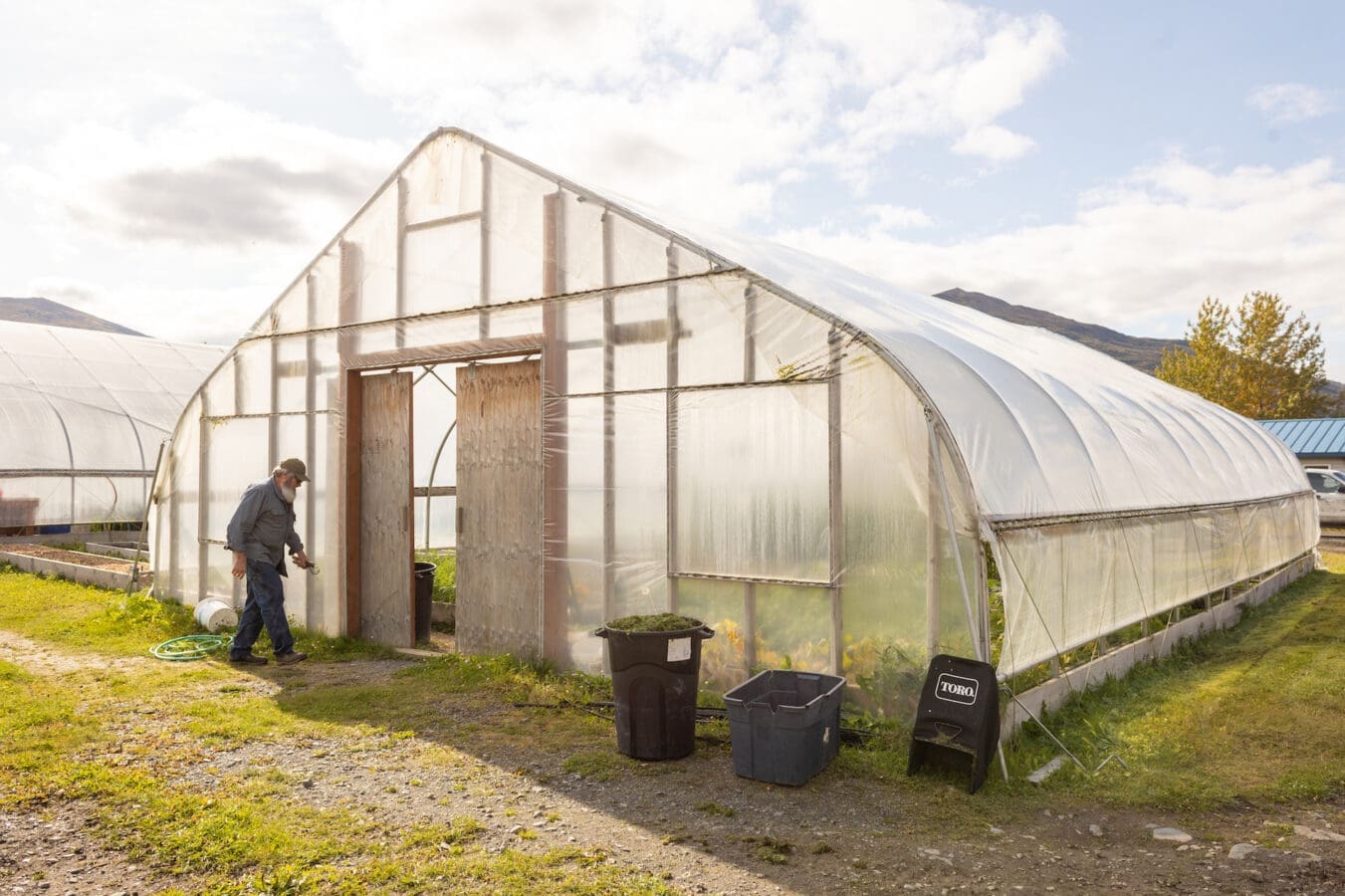The Kodiak Archipelago stretches 180 miles in the Gulf of Alaska. Its six villages lie on different coasts with distinct landscapes – from Akhiok’s tundra to Ouzinkie’s rainforest to Karluk’s sheer sea cliffs – they’re connected by seasons and subsistence. They hold thousands of years of Alutiiq culture, enduring through Russian colonization, epidemics, and tsunamis that forced several villages to relocate or rebuild entirely.
Food Security, Economic Growth and Rural Leadership in Kodiak
As summer begins, people on Kodiak are busy preparing for the first commercial salmon opener, or setting subsistence nets for early sockeye. Green rises slowly up the mountains. Sugar kelp farmers have harvested and put their farms to bed. Near Marlene’s Garden in Larsen Bay, cottonwoods unfurl over fiddlehead ferns and salmonberry blossoms. Sam Kenoyer has operated these hoop houses since 2015. Cayuga ducks and Barred Rock hens putter inside a large electric bear fence. A fisherman stops in to buy spinach and eggs.
“What I love is that everyone shows up happy. It’s just a pleasant way of life,” says Kenoyer. He plants his seeds each spring in the school building, the grow lights and trays of vegetable seedlings sharing space with books and art supplies in empty classrooms still decorated from before the school was closed. There aren’t enough kids living in the village in winter to keep it open.








Declining populations tied to limited economic opportunities is one challenge among many facing Kodiak’s villages. In 2005, this led to the creation of the Kodiak Archipelago Rural Regional Leadership Forum (the Forum). Marlene’s Garden is one of a network of island farms resulting from their early work.
 The Forum is a three-day gathering of rural community leaders held twice a year in Kodiak, centered around the long-term sustainability of the region’s coastal communities. For almost two decades, residents of the rural villages have gathered to advocate for solutions to challenges faced by marginalized, underserved rural and Indigenous communities – housing, ferry service, expensive fuel and electricity, aging facilities, water and sewer systems, a lack of jobs but also sometimes a lack of workforce.
The Forum is a three-day gathering of rural community leaders held twice a year in Kodiak, centered around the long-term sustainability of the region’s coastal communities. For almost two decades, residents of the rural villages have gathered to advocate for solutions to challenges faced by marginalized, underserved rural and Indigenous communities – housing, ferry service, expensive fuel and electricity, aging facilities, water and sewer systems, a lack of jobs but also sometimes a lack of workforce.
“We bring everybody together to articulate their goals and talk about how to get them done. That’s really what the Forum does, is develop a collective voice around whatever we’re working on at that time,” said Forum co-founder Robbie Townsend Vennel, who now serves as the executive director of the Kodiak Archipelago Leadership Institute (KALI), a non-profit formed to support the goals articulated by the Forum.

KALI has been a laboratory for how to solve the problems faced by small communities. The Forum follows a “deep democracy” model, fostering a respectful discussion process where every voice is counted. Each session is focused on advocacy and community development opportunities – energy and infrastructure needs, fisheries, education, funding opportunities, and conversations with regional, state, and federal leaders. With support from Alaska Venture Fund, the group is building out its capacity to share the model, and to grow more local facilitators who can build on the decades of success. At a recent Forum, residents from the Village of Igiugig in Southwest Alaska joined their Kodiak Archipelago neighbors to gain more insight into the process and its results, as they work to seed a similar effort for the communities around Lake Iliamna.
 Forum sessions balance dynamic discussion and hands-on work with learning from “best practices” presenters. There’s camaraderie after years of values-based collaboration, and humor too. Beanie babies are provided to participants to be tossed across the room at rule breakers if a cell phone rings or someone chimes in without waiting for the microphone.
Forum sessions balance dynamic discussion and hands-on work with learning from “best practices” presenters. There’s camaraderie after years of values-based collaboration, and humor too. Beanie babies are provided to participants to be tossed across the room at rule breakers if a cell phone rings or someone chimes in without waiting for the microphone.
Father Ioasaph, a Russian Orthodox priest from Old Harbor who keeps Forum meetings lighthearted with his jokes, says, “For the villagers that used to be in competition within the (Kodiak Island) Borough for limited resources, the thing that changed over the years was that we were all finding we had the same needs being equally unfulfilled. We developed a sense of ourselves as a voice.”
KALI has grown its “Forum family” into a valuable conduit between rural communities and agencies, legislators, and grants. “Organizations now come to us with opportunities because we’re a proxy. You can come to the Forum and reach all of our communities in one place,” said Townsend Vennel.
“For the villagers that used to be in competition within the (Kodiak Island) Borough for limited resources, the thing that changed over the years was that we were all finding we had the same needs being equally unfulfilled. We developed a sense of ourselves as a voice.”


KALI’s recent work centers on the nascent kelp farming industry, which aligns with its values and vision: potential for regenerative economic stability, a means of re-establishing relationships as Indigenous and community-based stewards, and a new sustainable seafood industry in the face of climate change.
“There’s a lot of opportunity in mariculture and I’m looking forward to KALI assisting our region to help establish kelp farms – to build the marketing and selling programs with a large group of partners,” says Townsend Vennel.
 KALI has been spearheading the development of regenerative mariculture in the Kodiak Archipelago and is currently developing the Qik’rtaq Regional Rural and Alaska Native Kelp Development Plan to establish a network of Alutiiq and community-owned kelp farms. They recently completed an in-person kelp farmer training program in collaboration with the University of Alaska Marine Advisory Program and Alaska Ocean Farms, a local company partnering with KALI to seed the industry. Four farms have been permitted in Old Harbor and Port Lions, and another in Ouzinkie is working through the process.
KALI has been spearheading the development of regenerative mariculture in the Kodiak Archipelago and is currently developing the Qik’rtaq Regional Rural and Alaska Native Kelp Development Plan to establish a network of Alutiiq and community-owned kelp farms. They recently completed an in-person kelp farmer training program in collaboration with the University of Alaska Marine Advisory Program and Alaska Ocean Farms, a local company partnering with KALI to seed the industry. Four farms have been permitted in Old Harbor and Port Lions, and another in Ouzinkie is working through the process.
“If our rural, regional and Alaska Native voice is not at the table, it’s not going to get built out in a way that’s beneficial to our communities,” says Townsend Vennel.


Midsummer in Larsen Bay, the fireweed is blooming, the beach rye tall enough to hide bears fishing at Humpy Creek near Marlene’s Garden, where Sam Kenoyer is filling produce boxes with beets and kale and giant heads of lettuce.
For Kenoyer, this work feels full circle. He first came to Larsen Bay as a health aide, and in those years he often thought, “If folks could start eating right, they’d be much better off.” It’s gratifying to be “feeding our village and the area, and having fresh, quality produce, providing nutrition and good health.”
Across Kodiak Island, the Alutiiq Grown farms are thriving.
“It’s so exciting to see something that started out as a two-and-a-half-hour work session at the Forum eight or nine years ago grow into five farms, farms expanding, hydroponics, food on the table, Elders getting free food. That is an amazing journey,” said Townsend Vennel. “It really came out of their articulation of what was needed in their community planning.”


At a 2008 Forum, KALI members identified food security as a priority. Ninety-five percent of Kodiak’s food is imported. Since then, KALI’s Alutiiq Grown, has grown into a “regional farming family” with an online food hub and continuing education for growers to expand and improve harvests, ensuring long-term farm sustainability. Across the region the program is helping communities address the high cost of groceries, improve village nutrition, and is creating more jobs. Farms are adding fruit trees. Hydroponic cabinets are offsetting the challenges of a short, cold growing season by allowing year-round production. The new Port Lions hydroponic farming operation should produce 15,000 heads of greens next year.
“The farms are just exploding with their expansion plans. It shows what we can do if we start with a good foundational discussion and foundational information and then we build the thing out,” says Townsend Vennel.
 In the long, late summer light, kids ride bikes down gravel roads to playgrounds built in each village in 2019, thanks to a partnership between KALI and the Kodiak Island Borough. Back then, Forum participants realized that Borough playground funding had been allocated in a way that left one village out. “A few of us stood up and said we would take a smaller playground for our community if you could leverage the leftover funds from our budget and come up with enough for another playground,” says Dorinda Kewan, who attended the Forum as a Port Lions city council member, mayor, and now as a facilitator.
In the long, late summer light, kids ride bikes down gravel roads to playgrounds built in each village in 2019, thanks to a partnership between KALI and the Kodiak Island Borough. Back then, Forum participants realized that Borough playground funding had been allocated in a way that left one village out. “A few of us stood up and said we would take a smaller playground for our community if you could leverage the leftover funds from our budget and come up with enough for another playground,” says Dorinda Kewan, who attended the Forum as a Port Lions city council member, mayor, and now as a facilitator.
Such collaboration is at the heart of KALI, which has grown rural leadership and fostered communication in the region for nearly twenty years, advancing economic and social well-being within the archipelago. KALI is a compelling model of what can be achieved when local entities work together to create equitable, sustainable futures for rural communities, on their terms and guided by traditional values.
Alaska Venture Fund has been honored to support KALI’s work in growing sustainable remote and rural communities through direct investment in their leadership and capacity development and in their priorities, such as sustainable food systems, rural and Indigenous participation in emerging economic engines such as kelp mariculture.. For more information about KALI, connect directly with Executive Director Roberta Townsend Vennel.
Words by Sara Loewen. Sara teaches writing at Kodiak College during the winter and spends the summer in Uyak Bay with her family, where they fish commercially for salmon.
Photos by Ellen Carty. Ellen is an Alaska-based adventure and travel photographer who specializes in encapsulating the whimsy and negative space of the most obscure Alaskan landscapes.
Published November 19, 2023
